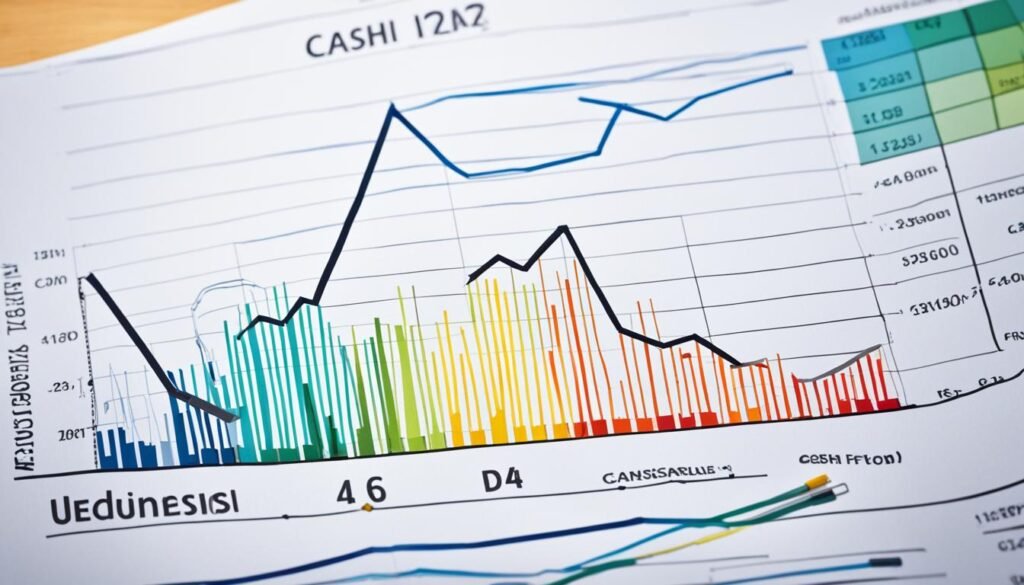Financial analysis is key for managing risk in all kinds of companies. The world’s economy is full of ups and downs, making it crucial for firms to spot, review, and lessen risks. This keeps their financial health and future success safe. Financial analysis looks into a company’s profitability, liquidity, solvency, and efficiency. By checking out financial data, companies can see risks coming, judge how big they might be, and make plans to reduce them.
Key Takeaways
- Financial analysis is a vital tool for effective risk management in businesses.
- It provides insights into a company’s profitability, liquidity, solvency, and efficiency.
- Analyzing financial data helps identify, assess, and mitigate potential risks.
- Effective risk management enables businesses to navigate challenges and protect their financial well-being.
- Financial analysis is crucial for making informed strategic decisions in today’s volatile economic environment.
Introduction to Financial Analysis in Risk Management Strategies
Effective risk management is key for success in business. It focuses on finding, understanding, and dealing with risks that could hurt a company’s finances. Financial analysis is at the core of this process. It gives insights and uses numbers to guide businesses through today’s complicated markets.
Understanding the Importance of Risk Management
Risk management is vital for a business’s long-term success. It helps companies spot risks early and deal with them. This way, businesses can stay strong, seize new chances, and protect their money and profits. Good risk management means making smarter choices, using resources wisely, and staying ready for market changes.
Also Read: How Can Cash Flow Statements Help In Financial Analysis?
Financial Analysis: A Crucial Tool for Risk Management
Financial analysis is crucial for managing risks. It helps companies understand their financial situation clearly. By looking at the numbers, businesses can see what risks might be out there and how they could be hit. With this deep understanding, they can make better strategic choices, making their risk management even stronger.
Key Components of Financial Analysis

Financial analysis looks at a company’s financial performance. It helps us understand and manage risks. We’ll look at how certain aspects of financial analysis help in risk management.
Profitability Analysis
This type of analysis checks how well a company can make profits. It looks at metrics such as profit margins, ROI, and ROE. These numbers tell us about a company’s financial health and its strengths. Analyzing profit helps spot risks like falling income, growing costs, and bad resource use.
Also Read: How Do I Save For Emergencies In My Financial Planning?
Liquidity Analysis
Liquidity shows if a company can pay its short-term debts. It uses ratios like the current and quick ratio. These ratios help find if there might be issues with cash flow, late payments, or debt not being repaid. This type of analysis helps reduce the risks of running out of cash or going bankrupt.
Solvency Analysis
This analysis looks at whether a company can handle its long-term debts. It uses metrics like debt-to-equity and interest coverage ratios. These ratios give us a picture of a company’s financial structure and debt management. Solvency analysis helps find risks tied to too much debt, failing to pay, or having to reorganize finances.
Efficiency Analysis
Efficiency analysis checks how well a company uses its assets and runs its operations. It involves ratios for asset, inventory, and accounts receivable turnover. These ratios talk about how smoothly a company’s operations are. They also help find risks like outdated products, bad stock handling, or slow payments.
Also Read: What Are The Financial Instruments Available For Wealth Growth?
Risk-Adjusted Return Analysis
This last type of analysis looks at the link between a company’s profits and the risks it takes. It uses metrics like RAROC and RAROA. These metrics give us a deep view of how a company deals with risk. This type of analysis guides companies to make balanced decisions that fit their risk preferences and goals.
| Financial Analysis Component | Key Metrics | Importance in Risk Management |
|---|---|---|
| Profitability Analysis | Profit margins, ROI, ROE | Identifies risks associated with declining revenues, rising costs, and inefficient use of resources |
| Liquidity Analysis | Current ratio, quick ratio | Helps mitigate risks related to financial distress and insolvency |
| Solvency Analysis | Debt-to-equity ratio, interest coverage ratio | Identifies risks associated with excessive debt, default, and financial restructuring |
| Efficiency Analysis | Asset turnover, inventory turnover, accounts receivable turnover | Helps identify risks related to obsolete inventory, poor inventory management, and lengthy collection periods |
| Risk-Adjusted Return Analysis | RAROC, RAROA | Provides a comprehensive understanding of a company’s risk-taking behavior and its impact on profitability |
Assessing Financial Performance Metrics for Risk Identification

Studying a company’s financial metrics is key for spotting risks and crafting good risk plans. By looking at metrics like revenue growth, profit margins, operating cash flow, debt levels, and inventory turnover, businesses get insights into their money health.
Also Read: How Do I Evaluate A Stocks Before Investing?
Revenue Growth
Healthy revenue growth shows a company is doing well financially and making money. But, too fast or unchecked growth can lead to issues. These include declining sales, cash flow problems, and default risk. It’s important to track growth and understand what’s driving it to reduce these risks.
Profit Margins
Looking at profit margins tells us about how well a company controls its prices, manages costs, and earns. If profit margins drop, it could mean more competition, higher input costs, or inefficient work. These issues might bring financial risks with them.
Operating Cash Flow
Operating cash flow shows how well a company is making cash from its main operations. This metric reveals any cash flow problems or shows how safe and liquid a company is financially. Keeping a close eye on operating cash flow helps companies make sure they have enough money for their short-term needs and to grow.
Debt Levels
Assessing a company’s debt levels can show us its financial leverage and solvency. Too much debt raises the default risk and can hurt the company’s financial health and stability. It’s crucial for businesses to watch their debt levels and keep their capital structure in good balance to avoid these financial risks.
Also Read: How Can I Calculate Capital Gains On Real Estate Investments?
Inventory Turnover
The inventory turnover ratio measures how well a company is dealing with its inventory. Slow inventory turnover might mean there’s some obsolete inventory or poor management. Such problems can lead to cash flow problems and declining sales. So, it’s important for businesses to keep a close watch on their inventory turnover to prevent these risks.
| Financial Performance Metric | Relevance to Risk Identification |
|---|---|
| Revenue Growth | Shows how well the company makes money and points out risks like declining sales, cash flow problems, and default risk. |
| Profit Margins | Helps understand how strong the company’s pricing, cost control, and profits are. Warns of risks from more competition and higher costs. |
| Operating Cash Flow | Indicates the company’s ability to turn main activities into cash. Helps to see any cash flow problems and check financial stability. |
| Debt Levels | Looks at the risk from financial leverage and ability to pay, with big debt levels increasing the danger of default and harming financial health. |
| Inventory Turnover | Checks how well inventory is managed, with low turnover pointing to dangers from obsolete inventory, poor inventory management, and declining sales. |
Analyzing Cash Flow and Liquidity in Risk Management

Cash flow and liquidity analysis are key parts of understanding financial risks. They let businesses see if they can make enough cash flow to pay bills quickly and handle surprises. By looking closely at cash flow and liquidity, companies can spot dangers early. They then make plans to face these dangers successfully.
Looking into cash flow shows how well a company manages its money short-term. This is vital for its obligations coming up soon. By checking the cash flow statement, companies can see where they might run low on cash. They can then make plans to fix this. This might include better working capital management, chasing up delayed payments, or getting quick loans.
Now, liquidity analysis gets to the point of checking if a company can pay what it owes soon. It uses figures like the current ratio and quick ratio to judge how good a company is at handling its short-term money needs. A good ratio that’s over 1 means the company probably can pay its short-term debts using what it has now.
| Ratio | Formula | Interpretation |
|---|---|---|
| Current Ratio | Current Assets / Current Liabilities | Measures a company’s ability to pay short-term obligations using its current assets. A ratio greater than 1 indicates good liquidity. |
| Quick Ratio | (Current Assets – Inventory) / Current Liabilities | Measures a company’s ability to meet its short-term obligations using its most liquid assets. A ratio greater than 1 indicates good liquidity. |
Studying cash flow and liquidity helps companies see risks ahead, like not having enough cash or missing bill deadlines. This knowledge lets them make smart moves to avoid these problems. Then, they can work towards staying financially secure and healthy in the long run.
Financial Analysis

Understanding a company’s financial health is key to managing risks. Financial analysis looks at ratios and statements to see how well a business is doing. It helps to spot and deal with risks.
Evaluating Financial Ratios for Risk Mitigation
Financial ratios give us an idea of how a company is doing financially. Profitability ratios like gross and net profit margins show where a business might struggle. Liquidity and solvency ratios tell us if a company can pay its bills now and later. By looking at these, companies can find and fix financial risks.
Utilizing Financial Statements for Risk Assessment
Looking at financial statements like the income, balance, and cash flow statements gives a complete picture. It shows us how much money the company makes, its debts, and if it’s running out of cash. This information is crucial for spotting and handling risks.
Incorporating Financial Forecasting into Risk Management
Using financial forecasting in risk management is key. It helps spot and deal with possible dangers. This method lets companies look ahead at their money trends. As a result, they can plan wisely and set up strategies to avoid risks.
Cash Flow Forecasting
Getting the cash flow forecast right is critical for managing risks. This part looks at expected money coming in and going out. It helps in seeing if there might be money troubles ahead. Also, it checks if the company can cover its bills soon. This way, businesses can ensure they have enough money to keep running and take on new chances.
Financial Modeling and Scenario Analysis
Financial modeling and scenario analysis are great for risk management. They let companies play out various financial situations. This includes looking at what might change in sales, costs, and the market. By doing these tests, companies can see how future changes could affect their money. Then, they can come up with plans to handle risks better and make smarter financial moves.
Breaking the whole thing down into key parts is also important. Sensitivity and variance analysis help see how forecasts react to changes. They point out where there might be risks hiding. These insights set companies up to plan ahead, use their resources better, and make solid choices even when things are uncertain.
| Key Financial Forecasting Techniques | Application in Risk Management |
|---|---|
| Cash Flow Forecasting | Anticipate liquidity risks, ensure short-term obligations are met |
| Financial Modeling | Simulate financial scenarios, assess potential impact, and develop mitigation strategies |
| Scenario Analysis | Evaluate the impact of changes in market conditions, revenue, and expenses on financial performance |
| Sensitivity Analysis | Understand the sensitivity of financial projections to changes in key variables and identify areas of risk |
| Variance Analysis | Analyze deviations between actual and forecasted financial results to uncover areas of risk and inform future planning |
Adding these forecasting tools to their risk plans makes companies stronger. It lets them foresee, check, and deal with various money risks. In the end, this boosts their financial health and their ability to make solid business decisions.
Leveraging Financial Analysis Tools and Software
Today’s business world is always changing. Companies that want to handle risks well need the best financial analysis tools. These tools help companies collect, look at, and understand financial info much quicker. This leads to smarter decisions in managing risk.
The tools and software for financial analysis can do a lot. They make it easier to manage risks by using things like data analysis, modeling, and forecasting. This means companies can look closely at their finances, spot risks, and plan ahead to avoid problems.
These tools also help find important trends and make reports. They use automation and data integration to speed up the process. This saves a lot of time and makes it easier to make smart decisions.
| Financial Analysis Tool/Software | Key Capabilities |
|---|---|
| Microsoft Excel | Spreadsheet-based financial modeling, ratio calculations, scenario analysis, and data visualization |
| Tableau | Advanced data visualization, trend analysis, and interactive dashboards for financial reporting |
| Oracle Hyperion | Enterprise-level financial planning, budgeting, and forecasting with robust risk management features |
| SAP Analytics Cloud | Comprehensive financial analytics, predictive modeling, and smart insights for strategic decision-making |
Using these tools and software can really improve how companies manage risks. They make choosing the right path clearer and help companies stay strong over time.
Also Read: Eassy Pay Finance: Your Ultimate Solution For Effortless Money Management And Smart Savings
Integrating Risk Management into Strategic Financial Decision-making
Integrating risk management into how a company makes financial decisions is key. It helps businesses stay financially stable and keep growing. With risk strategies tied to planning, they can choose wisely, weighing rewards against risks.
Capital Budgeting and Investment Decisions
In planning investments, analyzing finances and risks are vital. Businesses must look at potential upsides and downsides of each choice. They check the investment’s returns, how quickly they can turn it into cash, and if it is financially sound. By adding risk management to their planning, businesses safeguard their finances and increase their worth over time.
Mergers and Acquisitions
When companies come together or one buys another, there are big financial risks. This is where risk management is crucial. It helps in understanding the financial impact, handling new debts, and merging teams smoothly. With a good risk plan, the merging companies can thrive together, remaining strong financially.
Financing Strategies
Choosing the best way to fund operations is essential to handle financial risks. Careful financial analysis guides companies in picking the right finance mix, like loans, stocks, or both. They consider how these choices affect their operations and future stability. This way, companies set up plans that keep them financially secure in the long run.
FAQs
Q: What is financial analysis and why is it important in risk management?
A: Financial analysis is the process of evaluating the financial health and performance of a company by analyzing its financial statements and other relevant data. It is essential in risk management as it helps identify potential risks and opportunities, enabling businesses to make informed decisions to mitigate risks and maximize returns.
Q: What are the common types of financial analysis used in risk management?
A: The common types of financial analysis include ratio analysis, vertical analysis, horizontal analysis, cash flow analysis, and scenario and sensitivity analysis. These methods help assess a company’s financial strength, performance, and future outlook to manage risks effectively.
Q: How do financial analysts use financial statement analysis in risk management?
A: Financial analysts use financial statement analysis to examine a company’s income statement, balance sheet, and cash flow statement to evaluate its financial performance and position. By analyzing key financial ratios and trends, analysts can identify potential risks and opportunities, aiding in risk management strategies.
Q: What is the role of valuation in financial risk management?
A: Valuation is the process of determining the intrinsic value of a company or its assets. In risk management, valuation helps assess the worth of investments or projects, enabling businesses to make informed decisions regarding risk exposure and potential returns.
Q: How does financial analysis help in assessing the future performance of a company?
A: Financial analysis involves examining historical financial data, current financial position, and market trends to forecast the future performance of a company. By analyzing key performance indicators and financial ratios, businesses can anticipate potential risks and opportunities in their operations.
Q: What are the different leverage ratios used in financial risk management?
A: Leverage ratios, such as debt-to-equity ratio, debt ratio, and interest coverage ratio, help businesses evaluate their level of indebtedness and financial risk. These ratios indicate the company’s ability to meet its debt obligations and the extent of leverage used to finance its operations.
Q: How can financial analysis help in assessing the overall financial position of a company?
A: Financial analysis involves evaluating various aspects of a company’s financial health, including profitability, liquidity, solvency, and efficiency. By analyzing these factors through financial statements and ratios, businesses can gain a comprehensive understanding of their overall financial position and make informed decisions for risk management.




